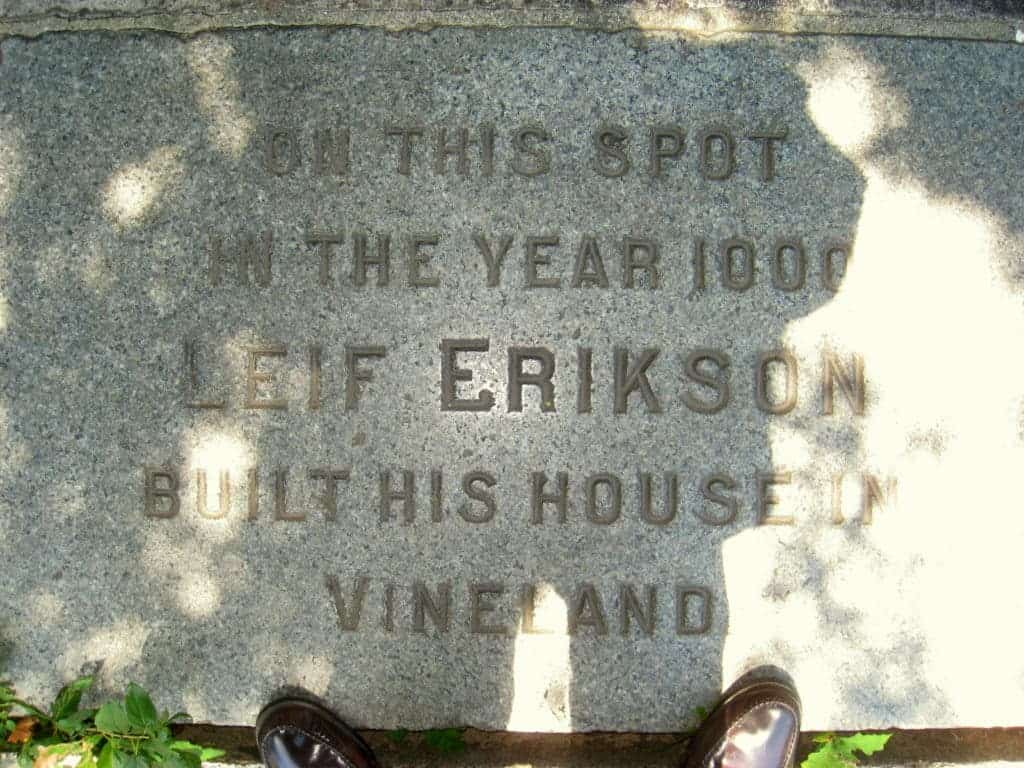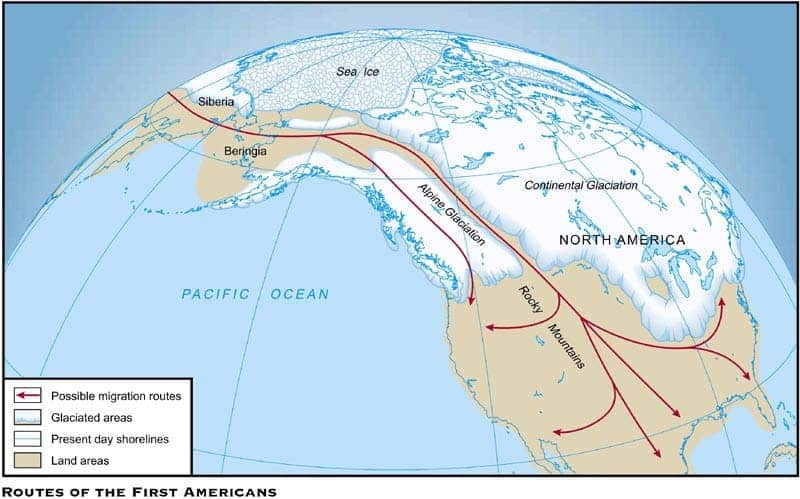Christopher Columbus is often credited with discovering the Americas. But while you can make a case for several discoveries, his is really not the one. You’d be closer to the truth by saying that Vikings or even Polynesians discovered America.
If Columbus didn’t discover America, then who?
There are several theories as to who “discovered” America, some more substantiated than others. We know for sure that Vikings were in America centuries before Columbus got there, and there is also (disputed) evidence that Polynesian explorers also visited the continent before the Spaniard. Technically, Nomadic Asian tribes first discovered America over 15,000 years ago — they made the first pioneering discoveries.
But let’s take it step by step.
The Columbus Expedition

In 1492, Columbus departed from Spain. Specifically, he set sail from the Spanish city of Palos de la Frontera with three ships. Ironically, Spanish citizens were forced to contribute to the expedition against their will, although that’s the smallest of Columbus’ sins.
Columbus wasn’t looking for new land or anything like that. In fact, the voyage was meant to find a new route to India, China, and Japan. If he could discover this new route, it would pave the way for many trading voyages that would make him rich. He was way off, but got lucky.
Fast forward a few weeks, and a lookout sailoron one of the ships saw land; an unknown coast was ahead of them. The captain of that ship (not Columbus) confirmed the sighting and alerted Columbus. Seizing the opportunity, Columbus later maintained that he himself had already seen a light hours beforehand — because the first man to see new land would earn a lifetime pension from the Spanish crown, and who could disagree with the captain?
That’s right, Columbus wasn’t really the nicest or most honest person. But that’s not even the case here. We don’t really know what land Columbus’ came across.
What island they found will remain a question for the ages. What we do know is that Columbus and his crew called it San Salvador; the natives called it Guanahani. It was an island in the Bahamas, but we don’t really know which one.
Columbus attacks the locals
They encountered friendly natives, who welcomed them peacefully. Columbus noticed the natives were wearing gold bracelets and necklaces; they had healthy crops and animals. So in true colonial fashion, he took six of them as slaves without hesitation. He wrote in his diary:
“They ought to make good and skilled servants, for they repeat very quickly whatever we say to them. I think they can very easily be made Christians, for they seem to have no religion. If it pleases our Lord, I will take six of them to Your Highnesses when I depart, in order that they may learn our language.”
Columbus was also pleased to note that they didn’t seem to have any weapons or army. “I could conquer the whole of them with 50 men, and govern them as I pleased,” the explorer wrote.
What happened later is well-known history. For the locals, it was genocide. For the Europeans of the time, it was a quick way to get incredibly rich and conquer new territories — which they did to the best of their ability. But there was no real discovery. Heck, a Milanese friar wrote about America centuries before Columbus’ journey.
Even conservative estimates suggest that in less than a decade, the population of the Island of Hispaniola plunged from 500,000 to less than 100,000, either from sickness or conflict with colonists. Columbus became rich beyond his wildest dreams: he was given 10% of all the removable assets of the newly discovered lands, including gold, silver, pearls, and precious stones, and the trade therein was to be a crown monopoly under his control.
Columbus’ “discoveries” paved the way for all of this. His voyages set sail for Asia, landed in a different place than he was expecting, and led to something tantamount to genocide. Is this really the person we want to celebrate for discovering America?
After all, other explorers discovered America centuries before him.
American Vikings reach North America

Sure, Columbus made America known to the Europeans who ultimately conquered it, but he didn’t discover it by any means. He also wasn’t the first European to reach the Americas. Centuries before him, the Vikings set foot on America.
Leif Erikson, the son of Erik the Red, was a Norse explorer from Iceland — a Viking. Erik the Red founded the first Norse settlement in Greenland. Discovery and expansion ran through their blood, as Leif went on to travel much farther: to America.
Leif and his crew traveled from Greenland to Norway in 999 AD, where he converted to Christianity. Not long after that, he sailed the Atlantic. According to the Sagas of Icelanders, he established a Norse settlement at Vinland, which is (debatably) in Newfoundland in modern-day Canada. For many years, this was thought to be only a mythological story — more myth than reality — but archaeological evidence has shown, beyond a doubt, that Vikings reached Canada.
The first Viking archaeological site in the New World is L’Anse aux Meadows, a thousand-year-old way station discovered in 1960 on the northern tip of Newfoundland. The feature was a clear indication that Vikings had visited North America centuries before Columbus — at least partially, the myth was proven to be true. Archaeologists actually used clues from the sagas to guide their research.

When archaeologists discovered another site, the second Viking settlement in America, things became much clearer. Not only have Vikings visited the American continent, but they actually colonized some parts of it — or at least attempted to do so.
“The sagas suggest a short period of activity and a very brief and failed colonization attempt,” says Douglas Bolender, an archaeologist specializing in Norse settlements. “L’Anse aux Meadows fits well with that story but is only one site. Point Rosee could reinforce that story or completely change it if the dating is different from L’Anse aux Meadows. We could end up with a much longer period of Norse activity in the New World.”
There is also other indirect evidence suggesting that Vikings went to America. Icelandic sagas claim that in 1004, Leif’s brother Thorvald Eiriksson was said to have sailed with a crew of 30 men, spending the following winter at Leif’s camp. In the spring, Thorvald attacked the local population and was ultimately killed by an arrow, but his crew appears to have remained in place. Just five years later, in 1009, Thorfinn the Valiant supplied three ships with livestock and 160 men and women — a proper colony. Accounts differ as to what happened to this colony, but the sagas mention a peace agreement between the indigenous peoples and the Norsemen.
So, we have solid evidence that Vikings — Leif and his extended family — visited America and remained then for at least 10 years. There is some evidence that they tried to establish an outpost, but the natives didn’t seem to appreciate their presence. Feeling threatened and outnumbered, the Vikings presumably left, though they likely returned from time to time to trade.
Another interesting piece of evidence was recently found by researchers analyzing Viking tombs: teeth filing. Researchers believe that the Vikings learned the practice from some other culture, but teeth filing was not done by any European culture. The only culture to employ such a practice was in America.
Polynesian yams and shakier claims
So ultimately, if you say that Leif Erikson discovered America, you’re way more right than if you say Columbus discovered America.
But the entire story doesn’t end here.
Did Polynesians also discover America?
Another population who probably visited America way before Columbus are the Polynesians. The main clue for this behavior is the inconspicuous sweet potato (yam).

The oldest carbonized sweet potato evidence in the Pacific hails back to about 1,000 A.D.—500 years before Columbus sailed to the Americas. But it wasn’t a convincing enough proof, so it remained as a hunch more than anything else.
However, French scientists found better samples from a herbarium collected by early European explorers. Through genetic analysis, they were able to show that Polynesians took the sweet potatoes from America and spread them across Southeast Asia and the Pacific, where they are now ubiquitous. There are also studies which link Brazilian DNA to that of Polynesians, though another recent study put the findings under question. It seems very likely that Polynesians did reach America and established some kind of trade route. If this happened, it was before Columbus’ time, but it’s not clear if it was before the Vikings.
Another intriguing analysis on Peruvian mummies found that at least one such mummy had been embalmed using resin from a tree that only grew only in Oceania and New Guinea. Both the mummy and the tree were dated to 1200 AD.
There is also a “China first” theory, but that’s highly speculative. While a massive Chinese fleet explored Africa, reaching present-day Kenya, there’s no real evidence to support that idea. Several explorers also claimed to have discovered the continent a few years before Columbus, but there’s almost no way to prove such claims.

The first discovery of America
So, we’ve established that while Columbus made America known to Europe’s colonial powers, he definitely wasn’t the first one. Polynesian sailors probably also visited South America. The Vikings discovered North America.
But if we really want to get true here, every time these explorers reached the continent, natives were already there. Because America was first discovered by humans over 15,000 years ago.
After all, when Columbus got there, and when the Vikings got there, there was always someone there to greet them.

Exactly when this happened is also a heated debate, but recent studies place the earliest migration rate between 25,000 and 15,000 years ago. Technically, you could say they were the first ones to discover America.
So at the end of the day, no matter how you look at it, Columbus didn’t really discover America. Who really discovered it can be a matter of interpretation — so take your pick between Polynesians, Vikings, or early humans. Maybe there’s even other civilizations that reached the continent but we haven’t figured it out yet.


